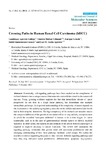Mostrar o rexistro simple do ítem
Crossing paths in Human Renal Cell Carcinoma (hRCC)
| dc.contributor.author | Aparicio Gallego, Guadalupe | |
| dc.contributor.author | Medina Villaamil, Vanessa | |
| dc.contributor.author | Grande Pulido, Enrique | |
| dc.contributor.author | Santamarina, Isabel | |
| dc.contributor.author | Antón-Aparicio, Luis M. | |
| dc.date.accessioned | 2017-08-29T09:51:15Z | |
| dc.date.available | 2017-08-29T09:51:15Z | |
| dc.date.issued | 2012-10-05 | |
| dc.identifier.citation | Aparicio Gallego G, Medina Villaamil V, Grande E, et al. Crossing paths in Human Renal Cell Carcinoma (hRCC). Int J Mol Sci [Internet]. 2012 Oct 5 [acceso 2017 Ago 29];13(10):12710-12733. Disponible en: http://www.mdpi.com/1422-0067/13/10/12710/htm | es_ES |
| dc.identifier.issn | 1422-0067 | |
| dc.identifier.uri | http://hdl.handle.net/2183/19365 | |
| dc.description.abstract | [Abstract] Historically, cell-signaling pathways have been studied as the compilation of isolated elements into a unique cascade that transmits extracellular stimuli to the tumor cell nucleus. Today, growing evidence supports the fact that intracellular drivers of tumor progression do not flow in a single linear pathway, but disseminate into multiple intracellular pathways. An improved understanding of the complexity of cancer depends on the elucidation of the underlying regulatory networks at the cellular and intercellular levels and in their temporal dimension. The high complexity of the intracellular cascades causes the complete inhibition of the growth of one tumor cell to be very unlikely, except in cases in which the so-called “oncogene addiction” is known to be a clear trigger for tumor catastrophe, such as in the case of gastrointestinal stromal tumors or chronic myeloid leukemia. In other words, the separation and isolation of the driver from the passengers is required to improve accuracy in cancer treatment. This review will summarize the signaling pathway crossroads that govern renal cell carcinoma proliferation and the emerging understanding of how these pathways facilitate tumor escape. We outline the available evidence supporting the putative links between different signaling pathways and how they may influence tumor proliferation, differentiation, apoptosis, angiogenesis, metabolism and invasiveness. The conclusion is that tumor cells may generate their own crossroads/crosstalk among signaling pathways, thereby reducing their dependence on stimulation of their physiologic pathways. | es_ES |
| dc.language.iso | eng | es_ES |
| dc.publisher | MDPI | es_ES |
| dc.relation.uri | http://dx.doi.org/10.3390/ijms131012710 | es_ES |
| dc.rights | Atribución 3.0 España | es_ES |
| dc.rights.uri | http://creativecommons.org/licenses/by/3.0/es/ | * |
| dc.subject | Human renal cell carcinoma (hRCC) | es_ES |
| dc.subject | Signaling pathway crosstalk | es_ES |
| dc.subject | Biomarker | es_ES |
| dc.title | Crossing paths in Human Renal Cell Carcinoma (hRCC) | es_ES |
| dc.type | info:eu-repo/semantics/article | es_ES |
| dc.rights.access | info:eu-repo/semantics/openAccess | es_ES |
| UDC.journalTitle | International Journal of Molecular Sciences | es_ES |
| UDC.volume | 13 | es_ES |
| UDC.issue | 10 | es_ES |
| UDC.startPage | 12710 | es_ES |
| UDC.endPage | 12733 | es_ES |
Ficheiros no ítem
Este ítem aparece na(s) seguinte(s) colección(s)
-
GI-FENM - Artigos [117]
-
INIBIC-OCT - Artigos [21]






